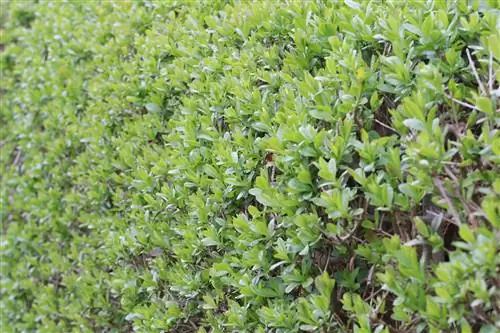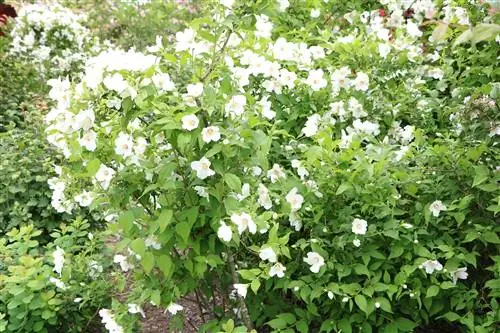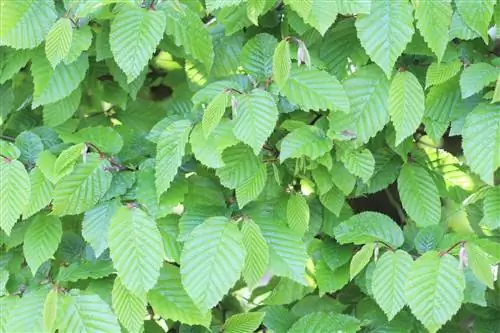- Author admin [email protected].
- Public 2023-12-17 03:39.
- Last modified 2025-01-24 12:45.
A hedge is more attractive than a wall or wooden privacy screen in the garden. And there are actually hedge plants that don't take long to reach a minimum height and density and can therefore serve as privacy screens after just a few years. The most popular fast-growing hedge plants are briefly introduced here.
Deciduous or coniferous plants? Everything has advantages and disadvantages
Most of the fast-growing hedge plants that are offered relatively cheaply in German stores are deciduous plants. These plants have the advantage that they are not so prickly, they have no thorns or needles, and some of them grow very densely. The disadvantage is that they shed their leaves in winter, so they are no longer useful as privacy screens. Of course, the branches become so dense over the years that even leaf-free hedges still offer privacy in winter, but that takes some time, even with fast-growing hedges. In general, coniferous plants require less care because the leaves have to be swept up in autumn. The animals that are attracted to the hedge are also different.
In general, all trees and bushes native to Germany are home to insects, birds and other animals, which in turn attract predators. While birds breed safely in dense coniferous trees and the corresponding noise and dirt must be expected, light deciduous trees are more interesting for insects. Fast-growing hedges need to be trimmed more often than slow-growing species, and with conifers there is the problem of disposing of the wood. Since the branches contain a lot of resin, they cannot easily be composted or used for mulching. This problem does not exist with most deciduous trees because the branches and twigs can be easily shredded.
Evergreen privacy screen that grows about 40 cm per year
Cherry laurel is one of the most popular hedge plants in Germany. The plants grow around 40 cm per year and quickly form an opaque hedge that stays green even in winter - because the cherry laurel does not shed its leaves in winter. A very dense hedge forms within just three years. However, all parts of the plants are poisonous; the leaves contain hydrogen cyanide and can cause poisoning if consumed. NABU therefore expressly warns against cherry laurel, which is already spreading in local forests and displacing other species. Another disadvantage is that the leaves do not compost well. Cherry laurel is quite undemanding, the plants tolerate sun to shade and like loamy soil and humus-rich soil equally. There should be a distance of around 80 to 100 cm between two plants; if necessary, you can plant a little closer together.
Field maple and hornbeam: native foliage plants
Field maple and hornbeam do not grow quite as quickly as cherry laurel. Both deciduous trees are native to Germany and provide a habitat for animals. Field maple grows around 50 cm per year, requires sunny or semi-shady locations, gets along with normal garden soil and is satisfied with two cuts per year. The plants are easy to care for and grow up to five meters high. Depending on the desired growth density and shape, two to three plants are required for one meter of hedge.
The situation is similar with the hornbeam, which is also called the hornbeam and is actually a birch tree. The plants shed their leaves relatively late in autumn, can grow to be several meters high and wide depending on how they are cut, should be cut once or twice a year and want sunny to partially shaded locations in normal garden soil. Young hornbeams still grow around 50 to 70 cm per year, older plants only grow 20 cm per year. The plants are non-toxic and serve as a habitat for many native species. About two to three plants are needed for one meter of hedge.
The native privet can grow up to one meter per year
Privet is not a tree, but a shrub, and the plant is semi-evergreen. The plants do not actually shed their leaves in winter, but they can be sensitive to frost and shed their leaves even in extremely wet conditions. Privet grows up to one meter a year and is up to five meters high. The plants tolerate pruning, so they can be shaped twice a year. Privet likes sunny and semi-shady locations and does well with normal garden soil. Privet is a native plant and is planted with three to five plants per meter of hedge.
European larch: deciduous coniferous plant
The European larch belongs to the pine family and is quite popular as a hedge plant. It is easy to care for, requires sunny locations and moist, deep garden soil. It grows up to 50 cm per year, is up to 40 m high and tolerates pruning well. About three plants are needed for one meter of hedge. The wood is quite hard and is used for roof trusses and other load-bearing structures. The larch needs only one cut per year; the wood has a calorific value in the fireplace like Douglas fir and pine - so it can be seasoned well and burned dry. Larch trees only really offer privacy in summer, as they do not grow so densely and shed their needle-shaped leaves in winter.
Tips for speed readers
- Fast-growing hedges are great when you need privacy quickly - but they don't stop growing and have to be cut more often than slow-growing varieties.
- Deciduous trees form beautiful hedges that, despite the lack of foliage, provide privacy through dense branches in winter. However, they are more work than coniferous plants because the leaves have to be swept in autumn.
- Coniferous trees are sometimes unpleasantly prickly, needles and any thorns that may be present can be unpleasant near seating areas. In addition, the hedge trimmings cannot be disposed of so easily due to the high hardness content.
- Cherry laurel is one of the most popular hedge plants, grows quickly and is undemanding, but it spreads so quickly in the local wild that NABU is now warning against the plants.
- Field maple grows up to 50 cm per year and can reach a height of five meters, but must be cut into shape twice a year.
- The hornbeam grows up to 70 cm per year, can reach several meters high and can cope with normal garden soil.
- Privet grows up to one meter annually and is planted quite densely with three to five plants per meter of hedge. It is hardy and only sheds its leaves in very cold or wet years.
- Larch trees do not grow as densely, shed their needle-shaped leaves in winter and then no longer provide any privacy. They are hardy, need moist soil and sunny locations, and can get by with just one cut per year.
If you want to have a high and dense hedge as a privacy screen or fence replacement in a short time, you can choose between different plants. The location is crucial. It is important to know whether it will be a sunny, semi-shaded or shady location. Not many plants are suitable for all three types of locations.
What you should know about fast-growing hedges in brief
Example: cherry laurel
Deciduous hedges are usually fast-growing. The cherry laurel is one of the particularly vigorous hedge plants. Although its height growth is greater than its width growth, it increases quickly and consistently. However, this means that it needs to be trimmed regularly. Since the branches can become as thick as an arm, the hedge trimmer is no longer of any use. You have to use the pruning shears and that's tiring. Otherwise, the cherry laurel is totally easy to care for and evergreen, which means that it provides privacy even in winter.
Example: Hornbeam
Hornbeam doesn't grow quite as quickly. It's best to use slightly larger plants at the beginning when planting the hedge. This hedge is also easy to care for. It is not evergreen, but even if the leaves lose their color, many of them remain on the plant. The hedge never becomes completely bare even in winter and looks beautifully colorful.
Example: Privet
A privet hedge is inexpensive to buy and also grows quickly. The plants are undemanding and constantly sprout. Privet is also evergreen. In particularly harsh winters it can sometimes lose its leaves. An older privet hedge is virtually impenetrable. The hedge blooms in spring and attracts birds with its fruit in autumn.
The hedge made of coniferous trees is usually evergreen. The yew tree is particularly suitable, but it is expensive to buy because it is almost only available in tree nurseries.
- The western yew is cheaper than the native yew. Yew trees should be at least 1.50 meters high when purchasing. They are undemanding and sprout again after every cut. In two years such a hedge grows approx. 30 cm.
- Thujas are considered cemetery plants, but are also suitable as hedges. They are easy to care for, opaque and inexpensive. In addition, with a few exceptions, they do not need to be circumcised. The same also applies to false cypresses.
- A good alternative to the commonly known thuja are Leyland cypresses, also known as bastard cypresses. They don't become bald on the inside and don't turn brown.
- Then there are so-called security hedges. They ensure safety even without a fence because they goad, poke, tear clothing and scratch skin.
- The Ilex, also called holly, has hard, spiny leaves. Anyone who tries to squeeze through such a hedge will be bitten. However, this hedge grows slowly and needs good soil, especially when planting.
Example: fire and hawthorn
Firethorn and hawthorn are even more prickly than holly. They have long, sharp thorns. If you don't prune them, they quickly grow to a height of three meters. Birds love these impenetrable hedges because they give them protection. The hawthorn needs more space than the firethorn. Some varieties are susceptible to rust. You should choose resistant plants.






